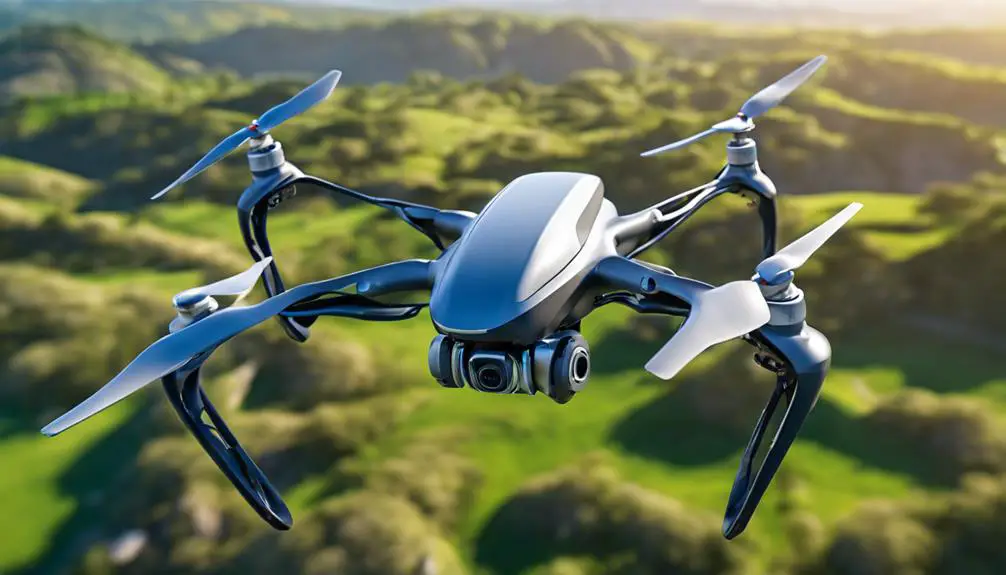Drones work by combining advanced tech with basic flight principles. They can fly on their own or be controlled remotely. You've got four forces at play: lift from propellers elevates the drone, while weight pulls it back to Earth. Motors generate thrust to propel it forward, balancing these forces for stable flight. Key components like frames, motors, and sensors help in navigation and control. From camera drones to delivery drones, each type serves a unique purpose. With continuous advancements and increasing applications, you'll discover even more fascinating insights about how drones function and their future potential.
Overview of Drone Technology
Drones, often called unmanned aerial vehicles (UAVs), utilize advanced technology to fly autonomously or be remotely controlled by a pilot. These incredible machines are equipped with sensors, cameras, and navigation systems that enable you to explore the skies without limits. With just a few taps on your device, you can capture breathtaking views or deliver essentials to hard-to-reach areas. The freedom drones offer is empowering, allowing you to map terrain, monitor wildlife, or even create stunning aerial footage. As you embrace this technology, remember that the possibilities are endless. Whether you're seeking adventure or practical solutions, drones can help you break free from traditional constraints, giving you a new perspective and a taste of boundless exploration.
Basic Principles of Flight
Understanding the basic principles of flight is essential for grasping how these remarkable machines navigate the skies. At the core, flight relies on four forces: lift, weight, thrust, and drag. Lift is generated by the drone's propellers, pushing air down to elevate it upward. Weight, or gravity, pulls the drone back to Earth. Thrust, produced by the motors, propels the drone forward, while drag is the resistance it faces moving through the air. By balancing these forces, you can achieve stable flight. When you manipulate these forces, you gain the freedom to explore the skies, capturing breathtaking views or delivering essential supplies, all while enjoying the exhilarating experience of flight. Embrace the freedom that drones offer!
Key Components of Drones
To achieve stable flight and maneuverability, every drone is built with specific key components that work together seamlessly. First, the frame provides the structure, allowing for durability without weighing you down. Next, you'll find the motors, which power the propellers to lift you into the skies. The electronic speed controllers (ESCs) manage the motor speeds, ensuring smooth adjustments during flight. A flight controller acts as the brain, processing inputs and maintaining stability. Don't forget the battery, which fuels your adventures, and the transmitter, allowing you to communicate your commands. Finally, sensors like GPS and cameras enhance your experience, giving you the freedom to explore new heights and capture stunning visuals. Each component plays a vital role in your aerial escapades.
Types of Drones
There are several types of drones designed for various purposes, each tailored to meet specific needs and preferences. Whether you're looking to explore, capture stunning visuals, or deliver goods, there's a drone for you. Here's a quick overview of some common types:
- Camera Drones: Perfect for photography and videography, letting you capture breathtaking aerial shots.
- Racing Drones: Built for speed and agility, these drones are designed for competitive flying.
- Delivery Drones: Used by companies to transport goods efficiently, offering a glimpse into the future of logistics.
- Agricultural Drones: Assist farmers in monitoring crops and managing resources, enhancing productivity.
Choose the type that suits your adventurous spirit and take to the skies!
Navigation and Control Systems
Piloting the skies requires sophisticated control systems that guarantee drones operate smoothly and efficiently, regardless of their type or purpose. These systems are the backbone of drone navigation, enabling you to soar through the air with precision. By utilizing GPS, drones can determine their position and plot a course, giving you the freedom to explore vast landscapes.
Moreover, advanced algorithms help maintain stability and control, allowing for agile maneuvers in unpredictable conditions. You'll find that many drones come equipped with user-friendly interfaces that make it easy to command your flight path. Whether you're capturing breathtaking views or surveying land, these control systems empower you to release your creativity and chase the horizon without constraints. Enjoy the freedom of flight!
Sensors and Cameras
Equipped with an array of sensors and cameras, drones can capture stunning imagery and gather essential data from the environment. These devices empower you to explore and document the world like never before. Here's what they typically include:
- High-Resolution Cameras: Perfect for capturing breathtaking aerial photos and videos.
- Infrared Sensors: Useful for detecting heat signatures, ideal for search and rescue missions.
- LiDAR Sensors: Great for mapping landscapes, delivering precise topographical data.
- GPS Modules: Guarantees accurate positioning, which helps in planning routes and tracking movements.
With these tools, your drone becomes a powerful extension of your freedom, enabling you to see the world from new perspectives and gather valuable insights anytime, anywhere.
Future of Drone Technology
As advancements in technology continue to unfold, the future of drone technology promises to revolutionize industries and everyday life in ways we can only begin to imagine. You'll see drones transforming delivery services, making logistics faster and more efficient, giving you the freedom to receive packages at your convenience. In agriculture, drones will provide real-time data, empowering farmers to optimize their yields and reduce waste. Emergency services will rely on drones for rapid response, saving lives in critical situations. Furthermore, as regulations evolve, you'll have opportunities to use drones for personal transport, granting you newfound mobility. As these innovations emerge, embracing drone technology will enhance your freedom, fostering a future where the sky's the limit.

